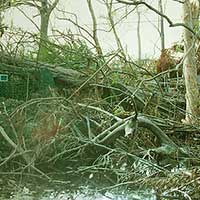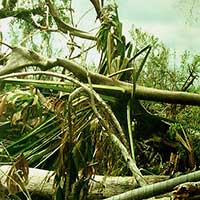
Saving Large Fallen Trees after Hurricane Andrew

Conference Proceedings of Association of Zoological Horticulture 1994
Audubon Zoo, New Orleans, Louisiana
Hurricane Andrew was a devastating storm that passed over South Florida on August 24, 1992. Parrot Jungle and Gardens had an effective hurricane plan and did not lose a single animal to the 160 mph winds. There was no way to protect the 14 acres of gardens and natural hammock area, where about 60% of the canopy was lost. Live oak (Quercus virginiana), bald cypress (Taxodium distichum), and pond apple (Annona glabra) were some of the large native trees that went over.
Now, over 2 years later, this is a report on how successful our efforts were in raising these trees, sometimes without the aid of mechanized equipment.The extent of the hurricane damage became apparent as people left the shattered buildings that had sheltered them during the storm. Although the wind was dying down there was still flying debris. A short walk that should have taken minutes took hours. The devastation was awesome, trees and wreckage were everywhere. The only cages that remained standing were the steel primate cages and the concrete and steel bird cages. Many of the other cages that had been evacuated the day before were crushed by large trees and some were also under water.
The Parrot Jungle is two miles from the bay and a canal that drains into this body of water passes within 200 feet from the Park. Hurricane Andrew occurred during high tide causing coastal flooding. The natural bodies of water in our hammock (about 20% of the entire Park) rose about seven feet. The alligator enclosure was completely covered with fallen trees although one alligator managed to swim out. This alligator was caught three weeks later when the Park was partially reopened to the public.
Hurricanes are a natural phenomena that once occurred frequently in South Florida. Although the last storm occurred 30 years ago, I was surprised to see how many large native trees had blown down. Many of the bald cypress were over l00 feet tall and, by counting the rings on some of the fallen trees, some were over 100 years old. The largest fallen oak trees had canopies up to 75 feet in diameter and were 50 to 60 feet tall. The national champion pond apple and its runner up were still standing, though most of the branches had been completely stripped off.There was no pattern to the damage. Approximately 40% of the large trees remained standing. What was apparent during the cleanup in the following months was that the majority of the fallen bald cypress had hollow trunks. These trees had usually snapped off at the widest point of the hollow.The cleanup in the hammock took months. The largest piece of equipment used was the chainsaw. All the work in this area was done by hand in order to salvage the thousands of plants underneath the debris. Trees that had a substantial amount of roots still attached were scheduled to be raised. The large fallen trees that had no attached roots were used as displays for epiphytes, usually where they lay. Small trees were not difficult to stand up by hand. The size and the nature of the hammock made access to the larger trees by crane impossible.
The solution to this problem was to use a giant tow truck. This truck had a 30 foot telescoping boom, with two separate winches. Each winch had a 200 foot cable and was able to pull 30,000 lbs. Using two cables allowed us to control the ascent of the tree. One cable came straight from the truck, while the other was routed through a secure object (usually the base of another tree about 40 to 50 degrees away) with a snatch block. The cables from the tow truck were attached to the fallen tree with a 4-inch nylon strap. This strap prevented girdling of the trunk which might have occurred if a cable had been used. The snatch block was also attached to a nylon strap. We used the tow truck to raise all of the fallen bald cypress which were within 200 feet of a road. The largest tree we raised was over 100 feet tall and had a trunk four feet d.b.h. (diameter at breast height). All trees once raised had at least four cables permanently attached. A thick rubber hose was used over the cable to prevent long term damage to the trunk. The cable used was 5/16" galvanized steel cable, capable of sustaining 6,000 lbs. of pull.All of the oak trees were over 200 feet from a road. These trees had to be raised by hand. To accomplish this, we used a 3-ton and a 5-ton chainfall. We also had an electrically operated 3-ton winch. This was run off a portable generator. Several of the largest trees required all three pieces of equipment at the same time. To raise one tree and to secure the permanent cables sometimes took six or seven hours with a crew of six men.
The most challenging of all the trees was a 70-foot bald cypress with a hollow trunk three feet dbh. The trunk had cracked at two different angles within ten feet of the ground and would have fallen if not held up by adjacent trees. We were able to cable the tree back into its original position. This normally would have been enough, but the cracks in the trunk rendered the tree unstable, and we briefly considered cutting it down because of its proximity to a public trail. We decided to secure the trunk. A drill bit five feet long was fabricated and seven holes were drilled through the trunk: four to one crack and three to the other. Screws five feet long were made of 12-inch threaded steel bars and placed through the holes. Steel plates were then bolted to the ends of the screws. A 5-foot length of 4-inch steel box tubing was bolted onto one row of screws to stabilize a crack that ran vertically for two feet. Once the tree was secure, the top 30 feet of the tree was removed to decrease wind resistance.
Our methods of securing the trees were very successful. One night, about a month after we finished raising the trees, we had a storm with winds of 60 mph. Not a single tree broke loose from its cables. The bald cypress that we had bolted together is doing very well. It has a canopy full of new growth and the cracks in the trunk are healing rapidly. About half of the bald cypress that we raised survived. All of the oak trees did very well. The only indication that they had once fallen down is the cables that are still attached to them. To our knowledge, many of the techniques we eventually worked out to save these trees had not been tried before in South Florida.




 About Hurricane & Typhoon Tree Recovery
About Hurricane & Typhoon Tree Recovery Ficus Species & Hurricane Horticulture
Ficus Species & Hurricane Horticulture Hurricane Tree and Palm Restoration
Hurricane Tree and Palm Restoration Saving Large Fallen Trees after Hurricane Andrew
Saving Large Fallen Trees after Hurricane Andrew